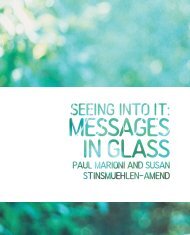Joan Takayama-Ogawa: Ceramic Beacon
The Craft in America Center is pleased to present a thirty-year survey of the provocative, playful and intricate ceramic sculpture of Joan Takayama-Ogawa.
The Craft in America Center is pleased to present a thirty-year survey of the provocative, playful and intricate ceramic sculpture of Joan Takayama-Ogawa.
Create successful ePaper yourself
Turn your PDF publications into a flip-book with our unique Google optimized e-Paper software.
12<br />
13<br />
ceramic beacon<br />
zaiden<br />
Tea was a focus for <strong>Takayama</strong>-<strong>Ogawa</strong> from the start due to<br />
its interwovenness with the history of ceramics. Tea-related<br />
objects also held personal cultural connotations and signified her<br />
Japanese-American family roots. As an Asian Studies major who<br />
spent a year in Japan during college, her heritage is central to her<br />
identity. She had a take on teaware that was however, distinctively<br />
her own. She stepped back from functional intentions and<br />
instead approached teaware as a strictly sculptural launching<br />
point. By 1990, she had developed her own signature “<strong>Ogawa</strong>-O”<br />
teapot (FIG. 1). Shaped like a doughnut, her tilted spin on the<br />
teapot had a large void at the center. It was a sharp contrast to<br />
the formality of Japanese ceramic canons. Flouting tradition, she<br />
began to find her own path. <strong>Takayama</strong>-<strong>Ogawa</strong> treated the elegant<br />
functional object as a surface for her gleaming painted decoration<br />
in her initial work with metallic glazes.<br />
(ABOVE, FIG. 1)<br />
Madhatter’s Teapot #1<br />
1990<br />
Glazed earthenware<br />
(RIGHT, FIG. 2)<br />
Sea Urchin Tea Set<br />
1992<br />
Glazed earthenware<br />
1991 was the first significant turning point in her artistic development<br />
after her father passed away. The natural world and its<br />
fragility were a pre-existing concern dating back to her college<br />
years in geography at ucla. With the loss of her father, this apprehension<br />
began to move towards the forefront in her outlook. The<br />
same year, she went to the same dive spot in Hawaii where she had<br />
always visited. For the first time, she noticed the coral was suffering.<br />
Human-induced environmental disaster became a topic she<br />
could not ignore, long before it became mainstream conversation.<br />
She tapped the textures, patterns, and colors of underwater life for<br />
some of her sculptural tea sets that paid homage to nature (FIG. 2).<br />
She began absorbing her outlook, fears, and proactive personality<br />
in the objects from that time on.
















